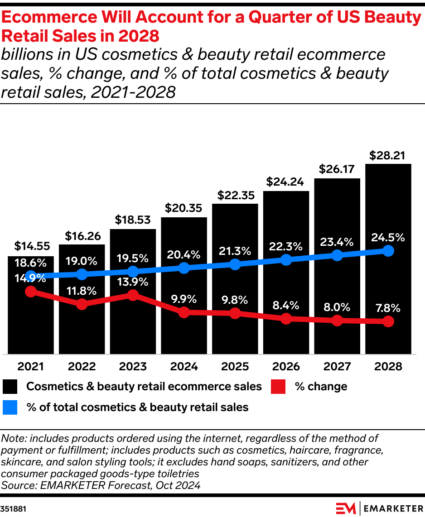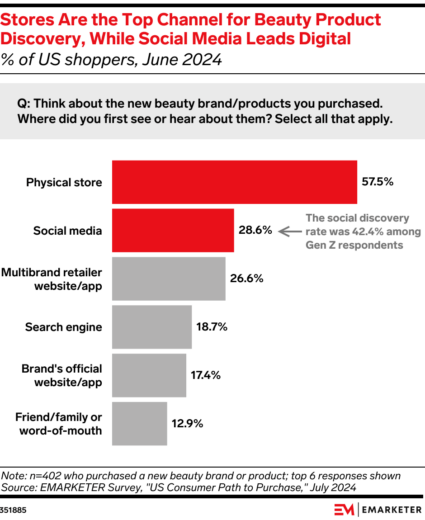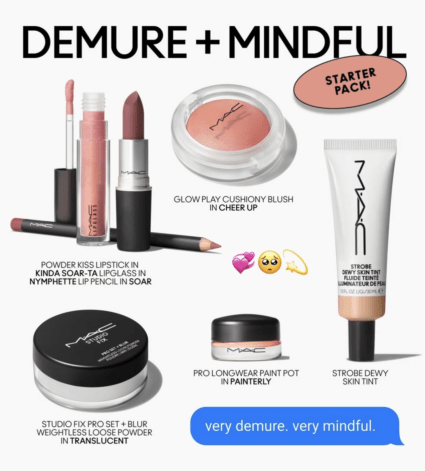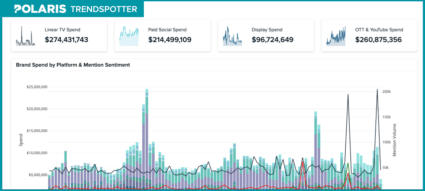Social media is a key tool in any marketer’s arsenal, but it’s especially essential for beauty brands. Beauty content has been part of the bedrock of feeds from TikTok to YouTube since the dawn of social platforms–and brands have taken advantage of this popularity for almost as long.
But today’s rapid social trend cycles aren’t for the faint of heart. Brands need to move fast to capitalize on new trends to get the most out of their social efforts.
An agile social strategy is non-negotiable for beauty brands. That’s why we’re breaking down what 2025’s social media cycles look like and how to stay ahead of the game and capitalize on trends in real time without missing a beat.
Set the scene: how beauty drives social media trend cycles
Cosmetics and beauty sales have been strong in the past few years, outpacing overall retail sales since 2022. Ecommerce is particularly successful for beauty brands; eMarketer projects that ecommerce will make up a quarter of beauty sales by 2028 despite slowing growth in the overall category.

Source: eMarketer
Social media fuels interest in beauty brands, which have embraced the role of creators from 2010s beauty YouTubers to today’s TikTok stars showing off their “morning sheds.”
They sponsor influencers, partner with creators to boost their social creative, and cultivate loyalty with key communities. According to eMarketer, 28.6% of US shoppers said they first heard about beauty products or brands on social media; that rate went up to 42.4% among Gen Z respondents.

Source: eMarketer
Despite its power as an engine of discovery, social media can be a challenging environment for marketers. Competition is rising in the beauty category as consumers cut back on spending due to economic pressure, and price-conscious audiences are fueling a strong culture of dupes online.
Young consumers are less loyal to brands than older cohorts and are willing to switch to lower-cost alternatives if a particular product doesn’t keep their attention.
To make matters worse, trend cycles have only sped up as social media has become more pervasive, making it harder and harder for marketers to stay relevant and maximize their impact on these platforms.
A good example of one of these rapid cycles is the “demure” fall of 2024, when beauty TikToker Jools Lebron’s funny audio about how to be “demure and modest” in the workplace caught on across social channels. Suddenly, every influencer was trading tips on how to be “mindful,” and every brand was eager to link their products to the trend.
Some brands worked directly with the creator to capitalize on the trend, while others built their own creative campaigns around it. MAC Cosmetics shared a “demure + mindful starter pack” on Instagram, suggesting products to help followers do their makeup for work.

Source: M.A.C. Cosmetics
Brands have very little time to catch on to a new trend before it’s too late (just a few weeks before we were all “demure,” it was still brat summer on TikTok). Quick responses are key; no matter how great your creative is, you can’t capitalize on a trend that’s already past its prime.
To win in 2025’s social media ecosystem, brands need to adapt quickly–keeping a pulse on your audience’s online behavior is paramount.
Take direction: social listening keeps your brand ahead of trends
With so many ways to consume content, capturing (and keeping) your audience’s attention can be challenging. You need to know what your target customers are engaging with online, so you can tailor your content to their specific preferences and habits.
On social media, the fastest way to get a picture of your ideal customer is social listening. Social listening gives real-time insight into how people view your brand and the conversations happening around your products or services so you can respond with the right content.
Beyond just tracking brand sentiment, a good strategy can also help you stay on top of what your target audience is talking about and what’s currently popular in the spaces they spend time in.
This visibility can also help you identify the people who are talking about your brand the most. Consumers value authenticity, and engaging with your biggest supporters (or detractors) can help you build a real connection with your audience.
To build a social listening strategy, start by finding the right tool. Not all social listening technology or methods are created equal; you should consider what you’re trying to accomplish and the data you want to analyze so you can get the best results possible for your brand.
Remember that a big part of the social listening experience is being bombarded by customer service complaints. Don’t ignore these, but be careful not to slip into a customer-service-reply-machine mindset and ignore the real aim of social listening: getting to know your audience and their interests in real time.
You can also stay on top of developments in areas like brand perception, public mindshare, and sentiment with a tool like our proprietary Polaris Trendspotter, which aggregates social media platform trends, competitive spend, brand spend, and social listening into a unified platform view for trend monitoring and predictions.

You can then leverage those insights to adapt your messaging and creative based on current trends or your audience’s interests.
Lights up: be ready to act fast on social media
Getting to know your audience is a great start, but reacting isn’t enough. You need to proactively find and create your own social media moments.
It’s key to prepare your social strategy to adapt to changes ahead of time. You can start by:
Creating a quick approval process
Knowing about the latest trends won’t do you much good if you can’t react to them quickly in your content and messaging. Updating creative quickly can be a challenge for many teams since convoluted approval processes and too many stakeholders can slow down the production of assets.
To solve this problem, you need to have a plan in advance for how you’ll adjust to changes. Talk to your team about what conversations or trends you’re willing to participate in versus those you’d like to avoid. If everyone is on the same page, your team can be more confident when making new creative quickly.
It’s also a good idea to outline a quick process for time-sensitive approvals, so you’re ready for any changes that come up in the future. Decide how timelines can be accelerated and how to keep approvers at the minimum to streamline your process.
Breaking down silos between departments
None of this will work if you don’t make sure all teams and departments communicate efficiently. If you have walls up between different channel teams or departments, you risk missing important updates or slowing down your response time.
Talk with all stakeholders ahead of time about what you’ll need to jump on relevant trends quickly, so you can anticipate logistical hurdles ahead of time. Make sure marketing, social media, and ecommerce can interact effectively.
Stacking your influencer bench
Tight social turnarounds can be tough for even the most nimble marketing teams, but you don’t have to go it alone. Influencers and creators can act as partners so you’re ready to take advantage of the latest social media trends.
Keeping some key influencers on deck means they can help you respond quickly. If you have an established brand relationship with an influencer in a target community, you can use also their knowledge to your advantage: they know the latest in their social niche better than any brand and can act as your guide to the communities you’re targeting.
Above all, remember that your brand is on social media to make an authentic connection with your audience. Make sure you’re committed to producing content that fits into your customers’ feeds, and they’ll be clicking “add to cart” in no time.







Responses